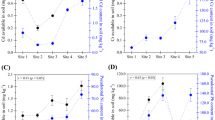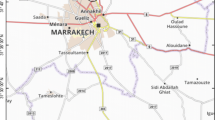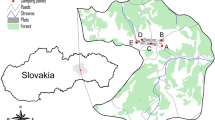Abstract
Soil contamination represents a serious and significant issue, especially when it comes to soil used in agricultural practices. This research was carried out in order to investigate the accumulation level of potentially toxic trace elements (Cr, Cd, Cu, Mn, Ni, Pb and Zn) in soil and vegetables (Solanum lycopersicum and Daucus carota). The transfer of the trace elements from soil to vegetables and the potential risk assessment were studied as well. Results indicated relatively high levels of heavy metals. Cd, Cu and Pb exceeded the alert limits established by the Romanian legislation. Zn was high as well. Positive correlations between the Cr, Cu and Pb indicated similar source of pollution, possibly related to the activities occurred in the non-metallic facility, nearby the study area. The heavy metals determined in the Solanum lycopersicum fruits and Daucus carota roots were below the maximum allowable concentrations, according to the WHO/FAO guideline. Slightly higher amounts of Cr and Cu were measured in tomatoes, compared to the carrots. Nevertheless, carrots were richer in Ni and Mn. The applied pollution indices indicated a contamination with heavy metals in 90% of the soil samples, with 9% probability of toxicity, the remaining 10% being classified into the precaution domain category. The plant bioconcentration of heavy metals into the Solanum lycopersicum fruits and Daucus carota roots is characterized using transfer factors. Generally, the results indicate that Daucus carota was the most susceptible to uptake Cu and Mn, while Solanum lycopersicum would rather uptake Cd and Zn. The estimated non-carcinogenic risk, based on the human health risk indices, indicates that the studied vegetables are safe for consumption with no impact on the human health. The results are lower than the critical value. Similarly, the carcinogenic risk indices results showed acceptable risks of cancer developing. It is important to assess and monitor the heavy metals levels in soil and in the vegetables intended to be consumed, in order to prevent contamination and potential negative effects on the environment and implicitly on the human health. The obtained data can be used in remediation techniques, as well as in implementing control measures of heavy metal contamination in soil and vegetables.




Similar content being viewed by others
Data availability
All data generated or analyzed in this study are included in this published article.
References
Alexander PD, Alloway BJ, Dourado AM (2006) Genotypic variations in the accumulation of Cd, Cu, Pb and Zn exhibited by six commonly grown vegetables. Environ Pollut 144:736–745. https://doi.org/10.1016/j.envpol.2006.03.001
Amin MdA, Rahman MdE, Hossain S, Rahman M, Rahmna MM, Jakariya Md, Sikder MdT (2020) Trace metals in vegetables and associated health risks in industrial areas of Savar. Bangladesh J Health Pollut 10:200905. https://doi.org/10.5696/2156-9614-10.27.200905
Antoine JMR, Hoo Fung LA, Grant CN (2017) Assessment of the potential health risks associated with the aluminium, arsenic, cadmium and lead content in selected fruits and vegetables grown in Jamaica. Toxicol Rep 4:181–187. https://doi.org/10.1016/j.toxrep.2017.03.006
Baghaie AH, Fereydoni M (2019) The potential risk of heavy metals on human health due to the daily consumption of vegetables. Environ Health Eng Manag J 6:11–16. https://doi.org/10.15171/EHEM.2019.02
Borioug M, Ezzaza K, Bouabid R, Alaoui-Mhamdi M, Bungau S, Bourgeade P, Alaoui-Sosse L, Alaoui-Sosse B, Aleya L (2020) Influence of hydro- and osmo-priming on sunflower seeds to break dormancy and improve crop performance under water stress. Environ Sci Pollut Res 27:13215–13226. https://doi.org/10.1007//s11356-020-07893-3
Briffa J, Sinagra E, Blundell R (2020) Heavy metal pollution in the environment and their toxicological effects on humans. Heliyon 6:e04691. https://doi.org/10.1016/j.heliyon.2020.e04691
Bungau S, Behl T, Aleya L, Bourgeade P, Aloui-Sosse B, Purza AL, Abid A, Samuel AD (2021) Expatiating the impact of anthropogenic aspects and climatic factors on long term soil monitoring and management. Environ Sci Pollut Res 202:30528–30550. https://doi.org/10.1007/s11356-021-14127-7
Cadar O, Miclean M, Cadar S, Tanaselia C, Senila L, Senila M (2015) Assessment of heavy metals in cow’s milk Rodnei mountains area, Romania. Environ Eng Manag J 14:2523–2528. https://doi.org/10.30638/eemj.2015.269
Chen C, Qian Y, Chen Q, Li C (2011) Assessment of daily intake of toxic elements due to consumption of vegetables, fruits, meat, and seafood by inhabitants of Xiamen. China J Food Sci 76:8. https://doi.org/10.1111/j.1750-3841.2011.02341.x
Cherfi A, Cherfi M, Maache-Rezzoug Z, Rezzoug SA (2016) Risk assessment of heavy metals via consumption of vegetables collected from different supermarkets in La Rochelle. France Environ Monit Assess 188:136. https://doi.org/10.1007/s10661-016-5140-7
Chowdhury AH, Chowdhury T, Rahman A (2019) Heavy metal accumulation in tomato and cabbage grown in some industrial contaminated soils of Bangladesh. J Bangladesh Agril Univ 17:288–294. https://doi.org/10.3329/jbau.v17i3.43198
FAO/WHO, Joint FAO/WHO (2011) Food Standards program Codex committee on contaminants in foods Food. CF/5 INF/1, 1–89.
Fosmire GJ (1990) Zinc toxicity. Am J Clin Nutr 51:225–227. https://doi.org/10.1093/ajcn/51.2.225
Gebeyehu HR, Bayissa LD (2020) Levels of heavy metals in soil and vegetables and associated health risks in Mojo area. Ethiopia Plos ONE 15:e0227883. https://doi.org/10.1371/journal.pone.0227883
Gitea MA, Gitea D, Tit DM, Purza L, Samuel AD, Bungau S, Badea GE, Aleya L (2019) Orchard management under the effects of climate change: implications for apple, plum and almond growing. Environ Sci Pollut Res 26(10):9908–9915. https://doi.org/10.1007/s11356-019-04214-1
Gong Q, Deng J, Xiang Y, Wang Q, Yang L (2008) Calculating pollution indices by heavy metals in ecological geochemistry assessment and a case study in parks of Beijing. J China University of Geosciences 19:230–241. https://doi.org/10.1016/S1002-0705(08)60042-4
Han FX, Banin A, Su Y, Month DL, Plodinec MJ, Kiingery WL, Triplett GE (2002) Industrial age anthropogenic inputs of heavy metals into the pedosphere. Naturwissenschaften 89:497–504. https://doi.org/10.1007/s00114-002-0373-4
He ZL, Yang XE, Stoffella PJ (2005) Trace elements in agroecosystems and impacts on the environment. J Trace Elem Med Biol 19:125–140. https://doi.org/10.1016/j.jtemb.2005.02.010
He Z, Shentu J, Yang X, Baligar VC, Zhang T, Stogffella PJ (2015) Heavy metal contamination of soils: Sources, indicators, and assessment. Journal of Environmental Indicators 9:17–18
Hoaghia MA, Roman C, Kovacs ED, Tanaselia C, Ristoiu D (2016) The evaluation of the metal contamination of drinking water sources from Medias town, Romania using the metal pollution indices. Studia UBB Chemia 61:461–471
Hoaghia MA, Levei EA, Cadar O, Senila M, Hognogi GG (2017) Assessment of metal contamination and ecological risk in urban soils situated near a metallurgical complex. Environ Eng Manag J 16:1623–1630. https://doi.org/10.30638/eemj.2017.175
Hoaghia MA, Cadar O, Hognogi GG, Levei E, Moisa C, Roman C (2019) Quality and human health assessment of metals and nitrogen compounds in drinking water from an urban area near a former non-ferrous ore smelter. Anal Lett. https://doi.org/10.1080/00032719.2018.1536136
Hu B, Jia X, Hu J, Xu D, Xia F, Li Y (2017) Assessment of heavy metal pollution and health risks in the soil-plant human system in the Yangtze River Delta, China. Int J Environ Res Public Health 14:1042. https://doi.org/10.3390/ijerph14091042
ISO 11466:1995, Soil Quality - Extraction of trace elements soluble in aqua regia. International Organization for Standardization, Geneve, Switzerland. https://www.iso.org/obp/ui/#!iso:std:19418:en. Accessed 14 May 2021
Kamunda C, Mathuthu M, Madhuku M (2016) Health risk assessment of heavy metals in soils from Witwaters-rang gold mining basin, South Africa. Int J Environ Res Public Health 13:663. https://doi.org/10.3390/ijerph13070663
Khan S, Dao Q, Zheng YM, Huang YZ, Zhu YG (2008) Health risks of heavy metals in contaminated soils and food crops irrigated with wastewater in Beijing, China. Environ Pollut 152:686–692. https://doi.org/10.1016/j.envpol.2007.06.056
Kim KH, Kim SH (1999) Heavy metal contamination of agricultural soils in central regions of Korea. Water Air and Soil Contamination 111:109–122. https://doi.org/10.1023/A:1005056310428
Kowalska J, Mazurek R, Michal G, Zaleski T (2018) Pollution indices as useful tools for the comprehensive evaluation of the degree of soil contamination - A review. Environ Geochem Health 40:2395–2420. https://doi.org/10.1007/s10653-018-0106-z
Lacatusu R, Lacatusu AR (2008) Vegetable and fruits quality within heavy metals polluted areas in Romania. Carpathian J Earth Environ Sci 3:115–129
Leblebici Z, Kar M, Basara L (2020) Assessment of the heavy metal accumulation of various green vegetables grown in Nevşehir and their risks human health. Environ Monit Assess 192:483. https://doi.org/10.1007/s10661-020-08459-z
Leitzmann C (2003) Nutrition ecology: the contribution of vegetarian diets. Am J Clin Nutr 78:657S-659S. https://doi.org/10.1093/ajcn/78.3.657S
Levei L, Cadar O, Kovacs E, Torok I, Ozunu A (2019) Biomonitoring of atmospheric metal pollution using northern white-cedar (Thuja Occidentalis) leaves. 12TH INTERNATIONAL CONFERENCE OF PROCESSES IN ISOTOPES AND MOLECULES (PIM 2019). Doi: https://doi.org/10.1063/5.0000188
Liang Y, Xiaoyun Y, Dang Z, Wang Q, Luo H, Tang J (2017) Heavy metal contamination and health risk assessment in the vicinity of a tailing pond in Guangdong, China. Int J Environ Res Public Health 14:1557. https://doi.org/10.3390/ijerph14121557
Liu WH, Zhao JZ, Ouyang ZY, Soderlung L, Liu GH (2005) Impacts of sewage irrigation on heavy metal distribution and contamination in Beijing, China. Environ Internat 31:805–812. https://doi.org/10.1016/j.envint.2005.05.042
Long ER, MacDonald DD, Smith L, Calder FD (1995) Incidence of adverse biological effects within ranges of chemical concentrations in marine and estuarine sediments. Environ Manag 19:81–97. https://doi.org/10.1007/BF02472006
Mahurpawar M (2015) Effects of heavy metals on human health. Int J Res – Granthaalayah 3:9seSE. https://doi.org/10.29121/granthaalayah.v3.i9SE.2015.3282
Manea DN, Ienciu AA, Stef R, Smuleac IL, Gergen II, Nica DV (2020) Health risk assessment of dietary heavy metals intake from fruits and vegetables grown in selected old mining areas—A case study: The Banat area of Southern Carpathians. Int J Environ Res Public Health 17:5172. https://doi.org/10.3390/ijerph17145172
Miclaus C, Pop C, Valcan B, Radu A, Rosu C (2019) Study of soil pollution with heavy metals in the town of Copsa Mica. Studia UBB Ambientum 64:37–54. https://doi.org/10.24193/subbambientum.2019.1.03
Miclean M, Cadar O, Levei AE, Roman R, Ozunu A, Levei L (2019) Metal (Pb, Cu, Cd, and Zn) transfer along food chain and health risk assessment through raw milk consumption form free-range caws. Int J Environ Res Public Health 16. https://doi.org/10.3390/ijerph16214064
Nassiri O, El Hachimi ML, Ambrosi JP, Rhoujjati A (2021) Contamination impact and human health risk in surface soils surrounding the abandoned mine of Zeida, high Moulouya, Northwestern Morocco. Environ Dev and Sustain https://doi.org/10.1007/s10668-021-01380-6
Ndibukke EEO, Egbe AO (2018) Heavy metals in cabbage, carrots and tomatoes sampled at Marian market, Calabar, Nigeria. IOSR-JESTFT 12:42–47. https://doi.org/10.9790/2402-1210014247
Nedelescu M, Baconi D, Neagoe A, Iordache V, Stan M, Constantinescu P, Ciobanu AM, Vardavas AI, Vinceti M, Tsatsakis AM (2017) Environmental metal contamination and health impact assessment in two industrial regions of Romania. Sci Total Environ 580:984–995. https://doi.org/10.1016/j.scitotenv.2016.12.053
Order 756 from the 3th of November 1997 for approving the Regulation regarding the assessment of environmental pollution, published in the Official Monitor No. 303bis from the 6th of 1997. http://legislatie.just.ro/Public/DetaliiDocument/13572. Accessed 14 May 2021
Pavel PB, Diacu E, Barbu CH (2013) Microwave-assisted digestion procedures for total lead and cadmium content determination in Copsa Mica soils. Rev Chim 64:1
Prajapati SK, Meravi N (2014) Heavy metal speciation of soil and Calotropis procera from thermal power plant area. Proceedings of the Int Academy Ecology Environ Sci 4:68–71
Radziemska M, Gusiatin ZM, Kowal P, Bes A, Majewski G, Jeznach-Steinhagen A, Mazur Z, Liniauskiene R, Brtnicky M (2020) Environmental impact assessment of risk elements from railway transport with use of pollution indices, a biotest and bioindicators. Hum Ecol Risk Assess-an International Journal 27:517–540. https://doi.org/10.1080/10807039.2020.1736984
Rahman MA, Rahmna MM, Reichman SM (2014) Heavy metals in Australian grown and imported rice and vegetables on sale in Australia: Health hazard. Ecotoxicol Environ Saf 100:53–60. https://doi.org/10.1016/j.ecoenv.2013.11.024
Samuel AD, Brejea R, Domuta C, Bungau S, Cenusa N, Tit DM (2017a) Enzymatic indicators of soil quality. J Environ Prot Ecol 18(3):871–878
Samuel AD, Tit DM, Melinte (Frunzulica) CE, Iovan C, Purza L, Gitea M, Bungau S (2017b) Enzymological and physicochemical evaluation of the effects of soil management practices. Rev Chim 68(10):2243–2247. https://doi.org/10.37358/RC.17.10.5864
Samuel AD, Bungau S, Tit DM, Melinte (Frunzulica) CE, Purza L, Badea GE (2018) Effects of long term application of organic and mineral fertilizers on soil enzymes. Rev Chim 69(10):2608–2612. https://doi.org/10.37358/RC.18.10.6590
Senila M, Senila L, Roman C (2011) Evaluation of performance parameters for trace elements analysis on perennial plants using ICP-OES technique. J Plant Develop 18:87–93
Six L, Smolders E (2014) Future trends in soil cadmium concentration under current cadmium fluxes to European agricultural soils. Sci Total Environ 485–486:319–328. https://doi.org/10.1016/j.scitotenv.2014.03.109
SR EN ISO 10304–1:2009 – Water quality. Determination of dissolved anions by ion chromatography in liquid faze. Part 1: Determination of bromide, chloride, fluoride, nitrate nitrite, phosphate and sulphate.
SR ISO 10390:2015 – Soil Quality – Determination of pH.
STAS 7184/1–84 Soils. Sampling for pedological and agrochemical studies (in Romanian).
Stasinos S, Nasopoulou C, Tsikrika C, Zabetakis I (2014) The bioaccumulation and physiological effects of heavy metals in carrots, onions, and potatoes and dietary implications for Cr and Ni: A Review. J Food Sci 79:765–780. https://doi.org/10.1111/1750-3841.12433
Su C, Jiang LQ, Zhang WJ (2014) A review on heavy metal contamination in the soil worldwide: Situation, impact and remediation techniques. Environ Skept Crit 3:24–38
Sultana MS, Rana S, Yamazaki S, Aono T, Yoshida S (2017) Health risk assessment for carcinogenic and non-carcinogenic heavy metal exposures from vegetables and fruits of Bangladesh. Cogent Environ Sci 3:1291107. https://doi.org/10.1080/23311843.2017.1291107
Tchounwou PB, Yedjou CG, Patlolla AK, Sutton DJ (2012) Heavy metal toxicity and the environment. Mol Clin Environ Toxicol 133–164. https://doi.org/10.1007/978-3-7643-8340-4_6
Thomlinson D, Wilson D, Harris C, Jeffrey D (1980) Problem in heavy metals in estuaries and the formation of pollution index. Helgol Mar Res 33:566–575. https://doi.org/10.1007/BF02414780
Torok AI, Moldovan A, Levei EA, Cadar O, Tanaselia C, Moldovan OT (2021) Assessment of lithium, macro- and microelements in water, soil and plant samples from karst areas in Romania. Materials 14. https://doi.org/10.3390/ma14144002
Toth G, Hermann T, Da Silva MR (2016) Heavy metals in agricultural soils of the European Union with implications for food safety. Environ Internat 88:299–309. https://doi.org/10.1016/j.envint.2015.12.017
Vosgan Z, Dippong T, Hoaghia MA, Mihali C, Mihalescu L (2021) Pedological characterization of soils in Gutai Mountains near a mining area, Romania. Environ Earth Sci 80:164. https://doi.org/10.1007/s12665-021-09473-1
Weissmannova HD, Pavlovsky J (2017) Indices of soil contamination by heavy metals – methodology of calculation for pollution assessment (minireview). Environ Monit Assess 189:616. https://doi.org/10.1007/s10661-017-6340-5
Weissmannova HD, Mihocova S, Chovanec P, Pavlovsky J (2019) Potential ecological risk and human health risk assessment of heavy metals pollution in industrial affected soils by coal mining and metallurgy in Ostrava, Czech Republic. Int J Environ Res Public Health 16:4495. https://doi.org/10.3390/ijerph16224495
WHO (2002) The world health report 2002: reducing risks, promoting healthy life, World Health Organization. https://apps.who.int/iris/handle/10665/42510. Accessed 14 May 2021
Wilcke W, Krauss M, Kobza J (2005) Concentrations and forms of heavy metals in Slovak soils. J Plant Nutr Soil Sci 168:676–686. https://doi.org/10.1002/jpin.200521811
Wuana RA, Okieimen FE (2011) Heavy metals in contaminated soils: A review of sources, chemistry, risks and best available strategies for remediation. ISRN Ecology 402647. https://doi.org/10.5402/2011/402647
Zhou H, Yang WT, Zhou X, Liu L, Gu JF, Wang WL, Zou JL, Tian T, Peng PQ, Liao BH (2016) Accumulation of heavy metals in vegetable species planted in contaminated soils and the health risk assessment. Int J Environ Res Public Health 13:289. https://doi.org/10.3390/ijerph13030289
Zimakowska-Gnoinska D, Bech J, Tobias FJ (2000) Assessment of the heavy metal contamination effects on the soil respiration in the Baix Llobregat (Catalonia, NE Spain). Environ Monit Assess 61:301–313. https://doi.org/10.1023/A:1006105329210
Zwolak A, Sarzynska M, Szpyrka E, Stawarczyk K (2019) Sources of soil pollution by heavy metals and their accumulation in vegetables: A Review. Water Air Soil Pollut 230:164. https://doi.org/10.1007/s11270-019-4221-y
Funding
This work was supported by the Ministry of Research and Innovation through Program 1—Development of the National Research and Development System, Subprogram 1.2—Institutional Performance—Projects for Financing Excellence in RDI, Contract No. 19PFE/2018 and by the Competitiveness Operational Programme of the Ministry of European Funds through the Contract No. 7/01.09.2016, MY SMIS 10565.
Author information
Authors and Affiliations
Contributions
Maria-Alexandra Hoaghia—conceptualization, investigation, methodology, writing—original draft and review & editing, validation; Oana Cadar—methodology, data analysis, editing, visualization; Corina Moisa—editing, visualization; Cecilia Roman—resources, supervision; Eniko Kovacs—methodology, writing original draft and review & editing, visualization.
Corresponding author
Ethics declarations
Consent for publication
Not applicable.
Ethics approval
Not applicable.
Consent to participate
Not applicable.
Competing interest
The authors declare that they have no competing interests.
Additional information
Responsible Editor: Lotfi Aleya
Publisher's Note
Springer Nature remains neutral with regard to jurisdictional claims in published maps and institutional affiliations.
Rights and permissions
About this article
Cite this article
Hoaghia, MA., Cadar, O., Moisa, C. et al. Heavy metals and health risk assessment in vegetables grown in the vicinity of a former non-metallic facility located in Romania. Environ Sci Pollut Res 29, 40079–40093 (2022). https://doi.org/10.1007/s11356-022-18879-8
Received:
Accepted:
Published:
Issue Date:
DOI: https://doi.org/10.1007/s11356-022-18879-8




